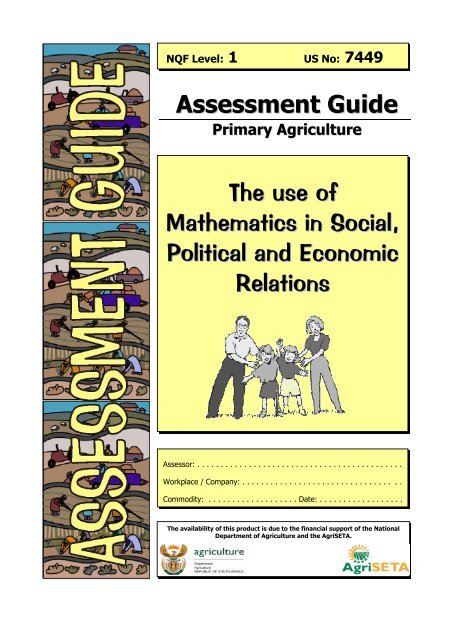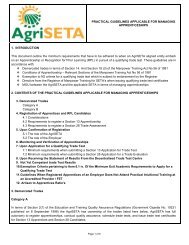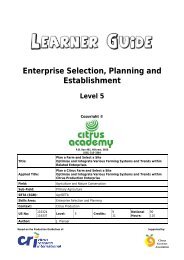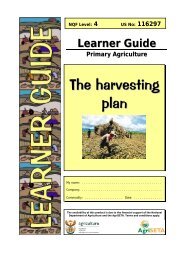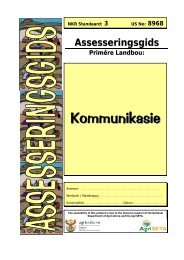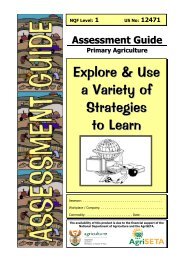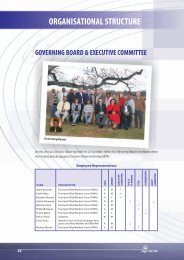Assessment Guide The use of Mathematics in Social ... - AgriSETA
Assessment Guide The use of Mathematics in Social ... - AgriSETA
Assessment Guide The use of Mathematics in Social ... - AgriSETA
- No tags were found...
Create successful ePaper yourself
Turn your PDF publications into a flip-book with our unique Google optimized e-Paper software.
Critically analyse how mathematics is <strong>use</strong>d <strong>in</strong> social, political and economicrelationsPrimary Agriculture NQF Level 1 Unit Standard No: 74492Before we start…This assessment guide conta<strong>in</strong>s all necessary activitiesand <strong>in</strong>structions that will enable the assessor andlearner to gather evidence <strong>of</strong> the learner’s competenceas required by the unit standard. This guide wasdesigned to be <strong>use</strong>d by a tra<strong>in</strong>ed and accredited assessorwhom is registered to assess this specific unit standardas per the requirements <strong>of</strong> the <strong>AgriSETA</strong> ETQA.Prior to the delivery <strong>of</strong> the program the facilitator andassessor must familiarise themselves with content <strong>of</strong> thisguide, as well as the content <strong>of</strong> the relevant LearnerWorkbook.Please Note:This Unit Standard7449 <strong>Assessment</strong><strong>Guide</strong> must be read<strong>in</strong> conjunction withthe generic Assessor<strong>Guide</strong> as prescribedand published by the<strong>AgriSETA</strong>.<strong>The</strong> assessor, facilitator and learner must plan the assessment process together, <strong>in</strong>order to <strong>of</strong>fer the learner the maximum support, and the opportunity to reflectcompetence.<strong>The</strong> policies and procedures that are required dur<strong>in</strong>g the application <strong>of</strong> thisassessment are available on the website <strong>of</strong> the <strong>AgriSETA</strong> and should be strictlyadhered to. <strong>The</strong> assessor must familiarise him/herself with this document beforeproceed<strong>in</strong>g.This guide provides step-by-step <strong>in</strong>structions for the assessment process <strong>of</strong>:Title:Critically analyse how mathematics is <strong>use</strong>d <strong>in</strong> social, political and economic relationsUS No: 7449 NQF Level: 1 Credits: 2This unit standard is one <strong>of</strong> the build<strong>in</strong>g blocks <strong>in</strong> the qualification listed below.Please mark the qualification you are currently assess<strong>in</strong>g, beca<strong>use</strong> that will bedeterm<strong>in</strong>ed by the context <strong>of</strong> application:Title ID Number NQF Level Credits MarkNational Certificate <strong>in</strong> Animal Production 48970 1 120 National Certificate <strong>in</strong> Mixed Farm<strong>in</strong>g Systems 48971 1 120 National Certificate <strong>in</strong> Plant Production 48972 1 120 Please mark the learn<strong>in</strong>g program you areenrolled <strong>in</strong>:Are you enrolled <strong>in</strong> a: Y NLearnership? Skills Program? Short Course? Note to Assessor:If you are assess<strong>in</strong>g thismodule as part <strong>of</strong> a fullqualification or learnership,please ensure that you havefamiliarized yourself with thecontent <strong>of</strong> the qualification.Version: 01 Version Date: July 2006
Critically analyse how mathematics is <strong>use</strong>d <strong>in</strong> social, political and economicrelationsPrimary Agriculture NQF Level 1 Unit Standard No: 744931SO 1Instructions to learner:Bra<strong>in</strong>storm <strong>in</strong> your groupLearner Workbook: Page 3 Facilitator <strong>Guide</strong>: Page 121. In your group, bra<strong>in</strong>storm as many activities as you can possibly come up withthat might <strong>use</strong> math <strong>in</strong> the workplace. Write key-words and concepts downbelow.Model Answer(s):Any mix<strong>in</strong>g,count<strong>in</strong>g,measur<strong>in</strong>g,plann<strong>in</strong>g lay-outs,stock control.My Notes …. . . . . . . . . . . . . . . . . . . . . . . . . . . . . . . . . . . . . . . . . . . . . . . . . . . . . . . . . . . . . . . . . . . . . . . . . . . . . .. . . .. . . . . . . . . . . . . . . . . . . . . . . . . . . . . . . . . . . . . . . . . . . . . . . . . . . . . . . . . . . . . . . . . . . . . . . . . . . . . . . . .. . . . . . . . . . . . . . . . . . . . . . . . . . . . . . . . . . . . . . . . . . . . . . . . . . . . . . . . . . . . . . . . . . . . . . . . . . . . . . . . .. . . . . . . . . . . . . . . . . . . . . . . . . . . . . . . . . . . . . . . . . . . . . . . . . . . . . . . . . . . . . . . . . . . . . . . . . . . . . . . . .. . . . . . . . . . . . . . . . . . . . . . . . . . . . . . . . . . . . . . . . . . . . . . . . . . . . . . . . . . . . . . . . . . . . . . . . . . . . . . . . .. . . . . . . . . . . . . . . . . . . . . . . . . . . . . . . . . . . . . . . . . . . . . . . . . . . . . . . . . . . . . . . . . . . . . . . . . . . . . . . . .. . . . . . . . . . . . . . . . . . . . . . . . . . . . . . . . . . . . . . . . . . . . . . . . . . . . . . . . . . . . . . . . . . . . . . . . . . . . . . . . .. . . . . . . . . . . . . . . . . . . . . . . . . . . . . . . . . . . . . . . . . . . . . . . . . . . . . . . . . . . . . . . . . . . . . . . . . . . . . . . . .. . . . . . . . . . . . . . . . . . . . . . . . . . . . . . . . . . . . . . . . . . . . . . . . . . . . . . . . . . . . . . . . . . . . . . . . . . . . . .. . . .. . . . . . . . . . . . . . . . . . . . . . . . . . . . . . . . . . . . . . . . . . . . . . . . . . . . . . . . . . . . . . . . . . . . . . . . . . . . . . . . .. . . . . . . . . . . . . . . . . . . . . . . . . . . . . . . . . . . . . . . . . . . . . . . . . . . . . . . . . . . . . . . . . . . . . . . . . . . . . . . . .. . . . . . . . . . . . . . . . . . . . . . . . . . . . . . . . . . . . . . . . . . . . . . . . . . . . . . . . . . . . . . . . . . . . . . . . . . . . . . . . .. . . . . . . . . . . . . . . . . . . . . . . . . . . . . . . . . . . . . . . . . . . . . . . . . . . . . . . . . . . . . . . . . . . . . . . . . . . . . . . . ..................................................................................Version: 01 Version Date: July 2006
Critically analyse how mathematics is <strong>use</strong>d <strong>in</strong> social, political and economicrelationsPrimary Agriculture NQF Level 1 Unit Standard No: 744942SO 1Instructions to learner:Answer the questionsLearner Workbook: Page 4 Facilitator <strong>Guide</strong>: Page 12Write down a formula to calculate each <strong>of</strong> the follow<strong>in</strong>g:1. Johanna earns R 12 per hour. She works 9 hours per day. She gets paidweekly. What is her weekly gross pay?Model Answer(s):R12 x 9 hours x 5 days = RR540 per week.2. <strong>The</strong>mba earns a gross salary <strong>of</strong> R 650 per week. He has weekly deductions forUIF at 1% <strong>of</strong> his weekly wage, and 1% SDL. What is his net wage per week?Model Answer(s):R650 – (1/100 x 650) – (1/100 x 650) = R637 per week.3. Xoli is the union representative. He has negotiated a wage <strong>in</strong>crease <strong>of</strong> 6% forthe workers on the farm. He has to expla<strong>in</strong> to two workers how much theywould now earn. <strong>The</strong> first worker is Sabatha who earns R 650.00 per week andthe second worker is Patience who earns R 660.00 per week.Model Answer(s):Sabatha:R650 + (650 x 6/100) = R689.00Patience:R660 + (660 x 6/100) = R699.60.4. If Xoli had negotiated a R60 across the board <strong>in</strong>crease – how would it changethe explanation <strong>of</strong> the wages for Sabatha and Patience above?Model Answer(s):Sabatha:R650 + R60 = R710Patience:R660 + R60 = R720.Version: 01 Version Date: July 2006
Critically analyse how mathematics is <strong>use</strong>d <strong>in</strong> social, political and economicrelationsPrimary Agriculture NQF Level 1 Unit Standard No: 744953SO 1Instructions to learner:Individual workLearner Workbook: Page 5 Facilitator <strong>Guide</strong>: Page 12You are work<strong>in</strong>g on a strawberry farm. <strong>The</strong>re are 10 people <strong>in</strong> the team. <strong>The</strong> teamhas been given the task <strong>of</strong> plant<strong>in</strong>g strawberry seedl<strong>in</strong>gs for the day. <strong>The</strong> teamleader has expla<strong>in</strong>ed that if all 5000 plants are planted with<strong>in</strong> 1 day, then the teamwill receive a bonus <strong>of</strong> R 500 for the week. But all the team members do not work atthe same rate (they are not equally productive).1. How will you measure each person’s productivity ratio, to make sure that thebonus is divided fairly between all the team members, accord<strong>in</strong>g to theirproductivity ratio?Model Answer(s):Devise a system where it can be recorded how many plants each person plants.Bonus at the end <strong>of</strong> the week: R500 bonus / 5000 plants = 10c per plant.For each planted that week, the person will receive a 10c bonus.My Notes …. . . . . . . . . . . . . . . . . . . . . . . . . . . . . . . . . . . . . . . . . . . . . . . . . . . . . . . . . . . . . . . . . . . . . . . . . . . . . .. . . .. . . . . . . . . . . . . . . . . . . . . . . . . . . . . . . . . . . . . . . . . . . . . . . . . . . . . . . . . . . . . . . . . . . . . . . . . . . . . . . . .. . . . . . . . . . . . . . . . . . . . . . . . . . . . . . . . . . . . . . . . . . . . . . . . . . . . . . . . . . . . . . . . . . . . . . . . . . . . . . . . .. . . . . . . . . . . . . . . . . . . . . . . . . . . . . . . . . . . . . . . . . . . . . . . . . . . . . . . . . . . . . . . . . . . . . . . . . . . . . . . . .. . . . . . . . . . . . . . . . . . . . . . . . . . . . . . . . . . . . . . . . . . . . . . . . . . . . . . . . . . . . . . . . . . . . . . . . . . . . . . . . .. . . . . . . . . . . . . . . . . . . . . . . . . . . . . . . . . . . . . . . . . . . . . . . . . . . . . . . . . . . . . . . . . . . . . . . . . . . . . . . . .. . . . . . . . . . . . . . . . . . . . . . . . . . . . . . . . . . . . . . . . . . . . . . . . . . . . . . . . . . . . . . . . . . . . . . . . . . . . . . . . .. . . . . . . . . . . . . . . . . . . . . . . . . . . . . . . . . . . . . . . . . . . . . . . . . . . . . . . . . . . . . . . . . . . . . . . . . . . . . . . . .. . . . . . . . . . . . . . . . . . . . . . . . . . . . . . . . . . . . . . . . . . . . . . . . . . . . . . . . . . . . . . . . . . . . . . . . . . . . . .. . . .. . . . . . . . . . . . . . . . . . . . . . . . . . . . . . . . . . . . . . . . . . . . . . . . . . . . . . . . . . . . . . . . . . . . . . . . . . . . . . . . .. . . . . . . . . . . . . . . . . . . . . . . . . . . . . . . . . . . . . . . . . . . . . . . . . . . . . . . . . . . . . . . . . . . . . . . . . . . . . . . . .. . . . . . . . . . . . . . . . . . . . . . . . . . . . . . . . . . . . . . . . . . . . . . . . . . . . . . . . . . . . . . . . . . . . . . . . . . . . . . . . .. . . . . . . . . . . . . . . . . . . . . . . . . . . . . . . . . . . . . . . . . . . . . . . . . . . . . . . . . . . . . . . . . . . . . . . . . . . . . . . . .Version: 01 Version Date: July 2006
Critically analyse how mathematics is <strong>use</strong>d <strong>in</strong> social, political and economicrelationsPrimary Agriculture NQF Level 1 Unit Standard No: 744964SO 1Instructions to learner:Complete the worksheetLearner Workbook: Page 6 Facilitator <strong>Guide</strong>: Page 12<strong>The</strong> average (mean) is calculated by add<strong>in</strong>g up the figures given and then divid<strong>in</strong>gby the total number <strong>of</strong> figures:Average = total amount + total number <strong>of</strong> figuresExample:1. F<strong>in</strong>d the average <strong>of</strong> 2, 4, 6.<strong>The</strong> total amount is 2 + 4 + 6 = 12<strong>The</strong>re are 3 numbers, so the average is 12 ÷ 3 = 41. Calculate the average <strong>of</strong> these figures:Model Answer(s):1. <strong>The</strong> total amount is 5 +12 + 7 = 24.<strong>The</strong>re are 3 numbers, so the average is 24 ÷ 3 = 8.2. <strong>The</strong> total amount is 6 + 9 + 15 = 30.<strong>The</strong>re are 3 numbers, so the average is 30 ÷ 3 = 10.3. <strong>The</strong> total amount is 21 + 32 + 28 = 81.<strong>The</strong>re are 3 numbers, so the average is 81 ÷ 3 = 27.4. <strong>The</strong> total amount is 44 + 37 + 48 + 35 = 164.<strong>The</strong>re are 4 numbers, so the average is 164 ÷ 4 = 41.5. <strong>The</strong> total amount is 92 + 76 + 88 + 80 = 336.<strong>The</strong>re are 4 numbers, so the average is 336 ÷ 4 = 84.6. <strong>The</strong> total amount is 103 + 98 + 87 + 95 + 102 = 485.<strong>The</strong>re are 5 numbers, so the average is 485 ÷ 5 = 97.7. <strong>The</strong> total amount is 1 003 + 989 + 654 + 1 226 = 3 872.<strong>The</strong>re are 4 numbers, so the average is 3 872 ÷ 4 = 968.Version: 01 Version Date: July 2006
Critically analyse how mathematics is <strong>use</strong>d <strong>in</strong> social, political and economicrelationsPrimary Agriculture NQF Level 1 Unit Standard No: 744975SO 2Instructions to learner:Work <strong>in</strong> pairsLearner Workbook: Page 7 Facilitator <strong>Guide</strong>: Page 141. Work out the perimeter <strong>of</strong> this triangle In pairs look up the mean<strong>in</strong>g <strong>of</strong> thefollow<strong>in</strong>g terms from a dictionary, then write next to it what you understand bythat term and how you might <strong>use</strong> it <strong>in</strong> your life (with a practical example).TermBudget<strong>in</strong>gDictionary mean<strong>in</strong>gAs per dictionary <strong>use</strong>dWhat I understand / anexample from my lifeAs per learners <strong>in</strong>itiativeInterestratesAs per dictionary <strong>use</strong>dAs per learners <strong>in</strong>itiativeMortgageAs per dictionary <strong>use</strong>dAs per learners <strong>in</strong>itiativeServicechargesAs per dictionary <strong>use</strong>dAs per learners <strong>in</strong>itiativeFuel pricesAs per dictionary <strong>use</strong>dAs per learners <strong>in</strong>itiativePensionsAs per dictionary <strong>use</strong>dAs per learners <strong>in</strong>itiativeInflationAs per dictionary <strong>use</strong>dAs per learners <strong>in</strong>itiativeValue <strong>of</strong> therandAs per dictionary <strong>use</strong>dAs per learners <strong>in</strong>itiativeExchangerates.As per dictionary <strong>use</strong>dAs per learners <strong>in</strong>itiativeVersion: 01 Version Date: July 2006
Critically analyse how mathematics is <strong>use</strong>d <strong>in</strong> social, political and economicrelationsPrimary Agriculture NQF Level 1 Unit Standard No: 744911Sex ratio:Infantmortalityrate:Lifeexpectancyat birth:Total fertilityrate:HIV/AIDS -adultprevalencerate:HIV/AIDS -people liv<strong>in</strong>gwithHIV/AIDS:HIV/AIDS -deaths:Ethnicgroups:Religions:Languages:Literacy:National StatisticAt birth: 1.02 male(s)/femaleUnder 15 years: 1.01 male(s)/female15-64 years: 0.95 male(s)/female65 years and over: 0.63male(s)/femaleTotal population: 0.95male(s)/female (2006 est.)Total: 60.66 deaths/1,000 live birthsMale: 64.31 deaths/1,000 live birthsFemale: 56.92 deaths/1,000 livebirths (2006 est.)Total population: 42.73 yearsMale: 43.25 yearsFemale: 42.19 years (2006 est.)2.2 children born/woman (2006 est.)21.5% (2003 est.)5.3 million (2003 est.)370,000 (2003 est.)Black African 79%, white 9.6%,coloured 8.9%, Indian/Asian 2.5%(2001 census)Zion Christian 11.1%,Pentecostal/Charismatic 8.2%,Catholic 7.1%, Methodist 6.8%,Dutch Reformed 6.7%, Anglican3.8%, other Christian 36%, Islam1.5%, other 2.3%, unspecified 1.4%,none 15.1% (2001 census)IsiZulu 23.8%, IsiXhosa 17.6%,Afrikaans 13.3%, Sepedi 9.4%,English 8.2%, Setswana 8.2%,Sesotho 7.9%, Xitsonga 4.4%, other7.2% (2001 census)Def<strong>in</strong>ition: age 15 and over can readand writeTotal population: 86.4%Male: 87%Female: 85.7% (2003 est.)Average <strong>of</strong> people<strong>in</strong> our groupExpressed aspercentagesVersion: 01 Version Date: July 2006
Critically analyse how mathematics is <strong>use</strong>d <strong>in</strong> social, political and economicrelationsPrimary Agriculture NQF Level 1 Unit Standard No: 744912Model Answer(s):As per group dynamics.2. Recall how political situations <strong>in</strong> the past applied mathematics to yourcommunity:Model Answer(s):As per learner <strong>in</strong>terpretation.3. Now briefly discuss how the application <strong>of</strong> BEE ratios might be <strong>of</strong> benefit toyour community:Model Answer(s):As per community benefit.My Notes …. . . . . . . . . . . . . . . . . . . . . . . . . . . . . . . . . . . . . . . . . . . . . . . . . . . . . . . . . . . . . . . . . . . . . . . . . . . . . .. . . .. . . . . . . . . . . . . . . . . . . . . . . . . . . . . . . . . . . . . . . . . . . . . . . . . . . . . . . . . . . . . . . . . . . . . . . . . . . . . . . . .. . . . . . . . . . . . . . . . . . . . . . . . . . . . . . . . . . . . . . . . . . . . . . . . . . . . . . . . . . . . . . . . . . . . . . . . . . . . . . . . .. . . . . . . . . . . . . . . . . . . . . . . . . . . . . . . . . . . . . . . . . . . . . . . . . . . . . . . . . . . . . . . . . . . . . . . . . . . . . . . . .. . . . . . . . . . . . . . . . . . . . . . . . . . . . . . . . . . . . . . . . . . . . . . . . . . . . . . . . . . . . . . . . . . . . . . . . . . . . . . . . .. . . . . . . . . . . . . . . . . . . . . . . . . . . . . . . . . . . . . . . . . . . . . . . . . . . . . . . . . . . . . . . . . . . . . . . . . . . . . . . . .. . . . . . . . . . . . . . . . . . . . . . . . . . . . . . . . . . . . . . . . . . . . . . . . . . . . . . . . . . . . . . . . . . . . . . . . . . . . . . . . .. . . . . . . . . . . . . . . . . . . . . . . . . . . . . . . . . . . . . . . . . . . . . . . . . . . . . . . . . . . . . . . . . . . . . . . . . . . . . . . . .. . . . . . . . . . . . . . . . . . . . . . . . . . . . . . . . . . . . . . . . . . . . . . . . . . . . . . . . . . . . . . . . . . . . . . . . . . . . . .. . . .. . . . . . . . . . . . . . . . . . . . . . . . . . . . . . . . . . . . . . . . . . . . . . . . . . . . . . . . . . . . . . . . . . . . . . . . . . . . . . . . .. . . . . . . . . . . . . . . . . . . . . . . . . . . . . . . . . . . . . . . . . . . . . . . . . . . . . . . . . . . . . . . . . . . . . . . . . . . . . . . . .. . . . . . . . . . . . . . . . . . . . . . . . . . . . . . . . . . . . . . . . . . . . . . . . . . . . . . . . . . . . . . . . . . . . . . . . . . . . . . . . .. . . . . . . . . . . . . . . . . . . . . . . . . . . . . . . . . . . . . . . . . . . . . . . . . . . . . . . . . . . . . . . . . . . . . . . . . . . . . . . . .. . . . . . . . . . . . . . . . . . . . . . . . . . . . . . . . . . . . . . . . . . . . . . . . . . . . . . . . . . . . . . . . . . . . . . . . . . . . . . . . .. . . . . . . . . . . . . . . . . . . . . . . . . . . . . . . . . . . . . . . . . . . . . . . . . . . . . . . . . . . . . . . . . . . . . . . . . . . . . . . . .. . . . . . . . . . . . . . . . . . . . . . . . . . . . . . . . . . . . . . . . . . . . . . . . . . . . . . . . . . . . . . . . . . . . . . . . . . . . . . . . .. . . . . . . . . . . . . . . . . . . . . . . . . . . . . . . . . . . . . . . . . . . . . . . . . . . . . . . . . . . . . . . . . . . . . . . . . . . . . . . . .Version: 01 Version Date: July 2006
Critically analyse how mathematics is <strong>use</strong>d <strong>in</strong> social, political and economicrelationsPrimary Agriculture NQF Level 1 Unit Standard No: 7449137SO 4Instructions to learner:Work <strong>in</strong> pairsLearner Workbook: Page 13 Facilitator <strong>Guide</strong>: Page 181. In pairs look up the mean<strong>in</strong>g <strong>of</strong> the follow<strong>in</strong>g terms from a dictionary, thenwrite next to it what you understand by that term and how you might <strong>use</strong> it <strong>in</strong>your life (with a practical example):TermIncomedistributionDictionary mean<strong>in</strong>gAs per dictionary <strong>use</strong>dWhat I understand / an examplefrom my lifeAs per learners <strong>in</strong>itiativeCensusAs per dictionary <strong>use</strong>dAs per learners <strong>in</strong>itiativeElectionsAs per dictionary <strong>use</strong>dAs per learners <strong>in</strong>itiativeVot<strong>in</strong>gAs per dictionary <strong>use</strong>dAs per learners <strong>in</strong>itiativeOp<strong>in</strong>ionpollsAs per dictionary <strong>use</strong>dAs per learners <strong>in</strong>itiativeMy Notes …. . . . . . . . . . . . . . . . . . . . . . . . . . . . . . . . . . . . . . . . . . . . . . . . . . . . . . . . . . . . . . . . . . . . . . . . . . . . . .. . . .. . . . . . . . . . . . . . . . . . . . . . . . . . . . . . . . . . . . . . . . . . . . . . . . . . . . . . . . . . . . . . . . . . . . . . . . . . . . . . . . .. . . . . . . . . . . . . . . . . . . . . . . . . . . . . . . . . . . . . . . . . . . . . . . . . . . . . . . . . . . . . . . . . . . . . . . . . . . . . . . . .. . . . . . . . . . . . . . . . . . . . . . . . . . . . . . . . . . . . . . . . . . . . . . . . . . . . . . . . . . . . . . . . . . . . . . . . . . . . . . . . .. . . . . . . . . . . . . . . . . . . . . . . . . . . . . . . . . . . . . . . . . . . . . . . . . . . . . . . . . . . . . . . . . . . . . . . . . . . . . . . . .. . . . . . . . . . . . . . . . . . . . . . . . . . . . . . . . . . . . . . . . . . . . . . . . . . . . . . . . . . . . . . . . . . . . . . . . . . . . . . . . .. . . . . . . . . . . . . . . . . . . . . . . . . . . . . . . . . . . . . . . . . . . . . . . . . . . . . . . . . . . . . . . . . . . . . . . . . . . . . . . . .. . . . . . . . . . . . . . . . . . . . . . . . . . . . . . . . . . . . . . . . . . . . . . . . . . . . . . . . . . . . . . . . . . . . . . . . . . . . . . . . .Version: 01 Version Date: July 2006
Critically analyse how mathematics is <strong>use</strong>d <strong>in</strong> social, political and economicrelationsPrimary Agriculture NQF Level 1 Unit Standard No: 744914<strong>Assessment</strong> Feedback FormComments / RemarksFeedback to learner on assessment:Feedback from learner to assessor:Learner’s Signature:Date:Assessor’s Signature:Date:Version: 01 Version Date: July 2006
Critically analyse how mathematics is <strong>use</strong>d <strong>in</strong> social, political and economicrelationsPrimary Agriculture NQF Level 1 Unit Standard No: 74491610. Income distribution; census; elections; vot<strong>in</strong>g;op<strong>in</strong>ion polls.<strong>Assessment</strong> Feedback FormComments / RemarksFeedback to learner on assessment and / or overall recommendations and action planfor competence:Feedback from learner to assessor:<strong>Assessment</strong> JudgementYou have been found: Competent Not yet competent <strong>in</strong> this unitstandardLearner’s Signature:Actions to follow: Assessor report to ETQA Learner results and attendancecertification issuedDate:Assessor’s Signature:Date:Moderator’s Signature:Date:Version: 01 Version Date: July 2006
Critically analyse how mathematics is <strong>use</strong>d <strong>in</strong> social, political and economicrelationsPrimary Agriculture NQF Level 1 Unit Standard No: 744917Version: 01 Version Date: July 2006


